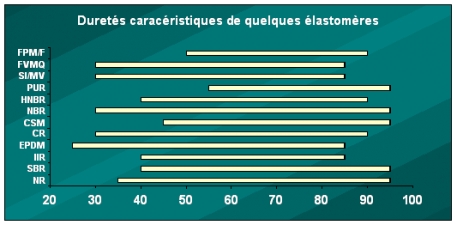RUBBER HARDNESS MEASUREMENT
On 28-01-2013
To evaluate elastomers quality, vulcanisation ratio, or even the wear resistance, it is necessary to check
the hardness. Measuring by pressing manually onto a rubber part in order to feel its resistance can seam
strange : a car tyre is hard, whereas a rubber pipe feels softer.
However, it is difficult to feel small hardness differences by hand. The only way to define hardness
precisely is to characterise the material comparing resistance that this material offers against pressure
applied with a harder part.
This is the way a durometer measures hardness by penetration.
The metal needle of the durometer is applied on to the rubber in precise conditions.

There are several durometer types :
A Shore or D Shore durometer (D stands for very high hardness), DIDC durometer, DIDC micro
durometer A Shore durometer, commonly used hardness meter :
Measure can be done with a hand instrument (small size), or with a fixed laboratory instrument,
the latter having the advantage of applying a precisely graded force.
The needle is linked to a calibrated spring, and the penetrating value is transferred on to a graduated
dial (0 to 100):
A soft rubber will show a low value between 0 and 40 A Shore.
An intermediate hardness rubber will show a value between 45 to 70 A Shore
A hard rubber will show a value between 75 and 100 A Shore

The test rubber : sample must have a 6 mm minimum thickness (one single layer, or by piling several
sample thicknesses). The distance between the needle and the edge of the tested sample must be of
at least 12 mm. And the surface must be flat.
Measurement is made with a room temperature of around 20°.

Instant Shore hardness : the measure is read as soon as the base of the instrument touches
the rubber surface.
This is the more commonly used method.
Shore harness after 15 seconds: the measure is read as above but 15 seconds later. The measured
value is always lower than the instant Shore hardness value.
The type of measure must always be specified to avoid any misunderstanding.
Duro check (direct hardness measure onto a rubber part) :
Any not flat surface will not allow a correct measure.
If the rubber is bond to a metal part, the value will be influenced by the metal proximity and will
be higher than without metal. "Hardness read with metal" will have to be marked on drawings
and on technical specifications.
DIDC DUROMETER (international rubber hardness) :
Measure is read in DIDC grades.
This type of measure is not possible with a hand instrument.
This instrument is fixed on a leg and has a vibration system.
The shape of the needle is different according to hardness scale.
The measure is read after 30 seconds of pressure on the needle.
The type of test rubber sample is the same than for the A Shore durometer
DIDC MICRO-DUROMETER :
This instrument allows measurements on small size rubber samples.
The needle is very thin.
Measure is made in DIDC grades.
HARDNESS MEASURES at CHEVALIER and CLÉRET :
All rubber mixtures made in our plants are measured in A Shore grades with a fixed instrument
and after 15 seconds. Thus avoiding instant reading mistakes for our systematic controls,
and manual force applied on the needle.
Our laboratory is also equipped with a DIDC micro-durometer, allowing hardness control
and measurements directly on parts, according to customers specifications, and to control
quality of our productions.

- NEWS N°184, Production of bipolar plates for fuel cells using the LSR injection process, type 3025-40 or EPDM, FKM, ...
- NEWS N° 182 - The CHEVALIER - CLERET - ELTEC Group in summury
- CHEVALIER CLERET ELTEC SILICONES - CAOUTCHOUCS ECO RESPONSIBLE - French Business Climate Pledge 11/12/2017
- FLUORINATED ELASTOMER FKM FPM RUBBER FOR PHARMACEUTICAL USES & FOOD CONTACT APPLICATIONS ALSO STERILIZABLE
- ELASTOMERS COMPARATIVE – TPE TPV THERMOPLASTICS ELASTOMER - HCR HEAT CURING ELASTOMERS
- TRIPLE ANNIVERSARY FOR CHEVALIER CLERET ELTEC RUBBER AND SILICONE AND LSR
- SELF LUBRICATED NITRILE NBR COMPOUND
- NITRILE NBR FOR GAZ APPLICATIONS NF EN 549
- RUBBER PARTS INSPECTION & "IN PRODUCTION" FUNCTIONNEL TESTS
- HOW TO GET MOULDED RUBBER PARTS & THERMOPLASTIC TP + SELF BONDING LSR CO INJECTION
- EXTREME PERFORMANCES FOR RUBBERS AND NEW OPPORTUNITIES THROUGH FLS FFLS FLUORO LIQUID SILICONE NEW GRADES AVAILIBITY
- RUBBER AND SILICONE LSR THERMAL EXPANSION
- RUBBER REUSE ( HIGH TEMPERATURE VULCANIZATION / CURE ELASTOMERS; SILICONES & LIQUID SILICONE RUBBERS / LSR)
- http://en.wikipedia.org/wiki/Synthetic_rubber
- http://en.wikipedia.org/wiki/Silicone
- HYBRIDS : LIQUID SILICONE RUBBER LSR SELF BONDING ON TP - THERMOPLASTIC (2on2) also named "self bonding lsr silicone"
- HYBRIDS : RUBBER BONDING ON METAL (1on2) also named "rubber metal"
- RUBBER FRICTION
- SILICONE AND RUBBER TEARING
- SILICONE AND RUBBER PARTS STORAGE
- RUBBER AND SILICONE TENSILE STRENGTH AND ELONGATION AT BREAK
- RUBBER TANGENT DELTA (TAN DELTA)
- RUBBER'S RESILIENCE
- YOUNG MODULUS FOR RUBBER
- RUBBER PARTS ASSEMBLING & MOUNTING
- RUBBER HARDNESS MEASUREMENT
- RUBBER COMPRESSION SET
- TO BE SEEN IN PHARMAPACK 2012 - Paris
- SILICONE AND ELASTOMERS SELF LUBRICATION
- ELASTOMERS POST CURING
- CUSTOM LSR COLORS
- 7 th TECH DAYS
- 6èmes journées techniques





